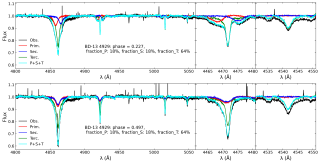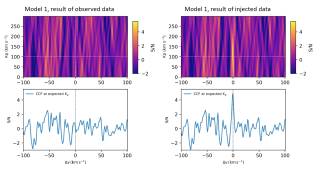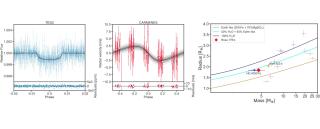We present photometric and spectroscopic observations of the members of three previously cataloged compact group (CG) candidatesat redshifts $z>0.3$. These confirm spectroscopic redshifts compatiblewith being gravitationally bound structures at redshifts 0.3112, 0.3848and 0.3643 respectively, and then they are the most distant CGs known with spectroscopic confirmation for all their members. The morphological and spectroscopic properties of all their galaxies indicate early types dominated by an old population of stars, with little star formation or nuclear activity. Most of the physical properties derived for the three groups are quite similar to the average properties of CGs at lower redshifts. In particular, from the velocities and positions of the respective members of each CG, we estimate short dynamic times. These leave open the questions of identifying the mechanism for forming CGs continuously and the nature of the final stages of these structures.
Advertised on
References
It may interest you
-
 The most massive stars in the universe are often born and evolve in binary and multiple systems — that is, in pairs or groups bound by their mutual gravity. Understanding how they interact with each other is key to explaining everything from their formation to the impact they have on the galaxies they inhabit. The MONOS project (Multiplicity Of Northern O-type Spectroscopic systems) aims to study these systems in the northern sky, combining spectroscopic observations (which analyze light split into its component colors to measure stellar velocities and physical properties) with photometryAdvertised on
The most massive stars in the universe are often born and evolve in binary and multiple systems — that is, in pairs or groups bound by their mutual gravity. Understanding how they interact with each other is key to explaining everything from their formation to the impact they have on the galaxies they inhabit. The MONOS project (Multiplicity Of Northern O-type Spectroscopic systems) aims to study these systems in the northern sky, combining spectroscopic observations (which analyze light split into its component colors to measure stellar velocities and physical properties) with photometryAdvertised on -
 The rocky planet GJ 1132 b, with Earth-like mass and radius, is a prime candidate for atmospheric studies. Previous observations with Hubble and JWST yielded conflicting results about its atmosphere. This study used three transit observations with the CRIRES+ instrument to search for He i, HCN, CH₄, and H₂O in GJ 1132 b's atmosphere. No clear atmospheric signals were detected, but upper limits for CH₄, HCN, and H₂O were established. The results suggest that if GJ 1132 b has an atmosphere, it is not dominated by hydrogen. The work highlights the challenges of detecting high molecular weightAdvertised on
The rocky planet GJ 1132 b, with Earth-like mass and radius, is a prime candidate for atmospheric studies. Previous observations with Hubble and JWST yielded conflicting results about its atmosphere. This study used three transit observations with the CRIRES+ instrument to search for He i, HCN, CH₄, and H₂O in GJ 1132 b's atmosphere. No clear atmospheric signals were detected, but upper limits for CH₄, HCN, and H₂O were established. The results suggest that if GJ 1132 b has an atmosphere, it is not dominated by hydrogen. The work highlights the challenges of detecting high molecular weightAdvertised on -
 The TESS (Transiting Exoplanet Survey Satellite) mission has discovered many exoplanet candidates that need to be confirmed and characterized from the ground. One of them orbits Ross 176, a K-type dwarf star, where we have identified a promising hot “water-world” candidate. Using spectroscopic observations with the CARMENES instrument, we confirmed the planetary nature of the signal detected by TESS and estimated the planet’s mass. To improve the analysis, we applied an advanced statistical method called Gaussian Process, which allowed us to separate the star’s own variability (quite strongAdvertised on
The TESS (Transiting Exoplanet Survey Satellite) mission has discovered many exoplanet candidates that need to be confirmed and characterized from the ground. One of them orbits Ross 176, a K-type dwarf star, where we have identified a promising hot “water-world” candidate. Using spectroscopic observations with the CARMENES instrument, we confirmed the planetary nature of the signal detected by TESS and estimated the planet’s mass. To improve the analysis, we applied an advanced statistical method called Gaussian Process, which allowed us to separate the star’s own variability (quite strongAdvertised on